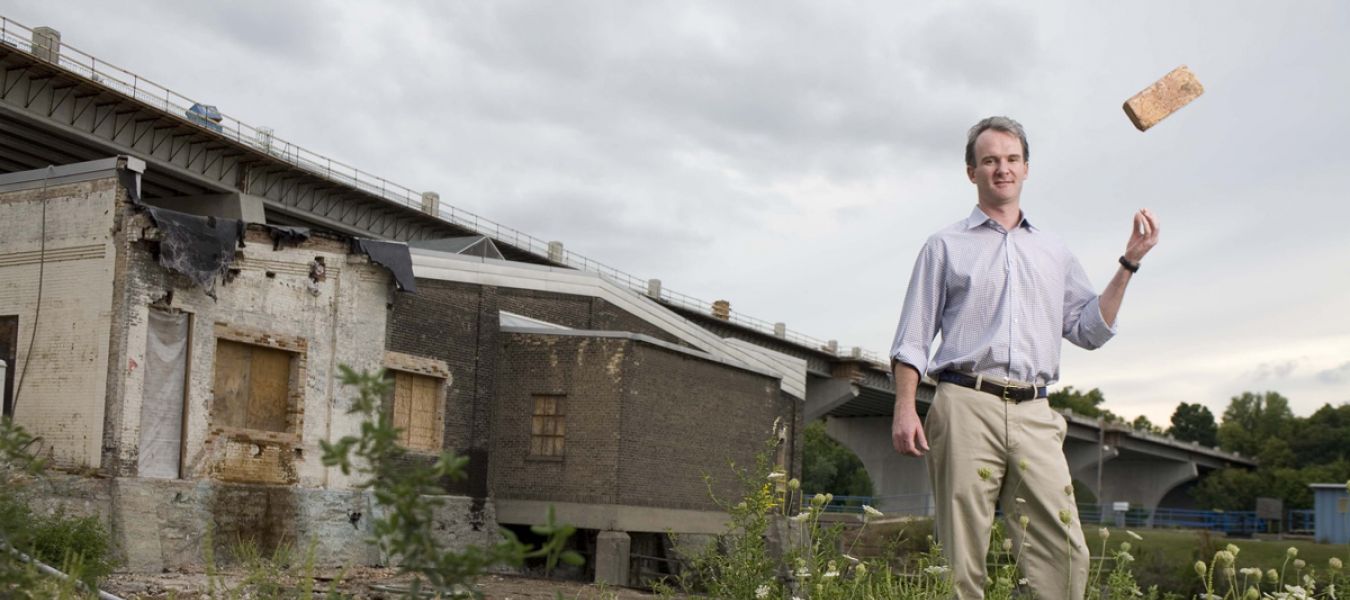
T'05
Mark Geall
Principal, Tanesay Development
If we're going to change people's minds, it's going to be because it's more profitable to build this way.
Take a wrong turn in a strange city and you just might happen upon the type of real estate that Mark Geall T'05 has spent a good part of his career examining: hulking industrial complexes that at one time may have belched black smoke, leaked contaminants, or emitted an odor so pungent that motorists would have had to hold their noses as they drove by. While working as assistant regional counsel at the Environmental Protection Agency in Chicago, it fell on him to investigate these kinds of unsavory sites. "I can't tell you how many mysterious records-room fires I ran across," he recalls. These days, however, Geall doesn't visit such places to make a bust. He comes to buy. And then he rebuilds, with sustainable—and profitable—practices as a foundation.
For some real estate developers, virgin land holds a certain irresistible allure. Slash deep enough into the wilderness, the thinking goes, and you'll source untouched acreage that can be molded to a particular purpose with little hassle from external forces. Geall's entrance strategy couldn't be more different. As the owner and operator of Chicago-based Tanesay Development, he specializes in transforming tainted urban industrial sites nobody wants into clean and green mixed-use developments.
Take RiverHeath, for example, a complex he's developing on 15 acres of land in Appleton, Wis., approximately 100 miles outside Milwaukee. It was once the site of the Consolidated Paper Mill, which loomed large along the banks of the Fox River near the center of town. Cleaning up contaminants on the site involved the removal of 50,000 tons of affected soil. "For months, there was a steady stream of bulldozers and dump trucks moving dirt off site and then back on," says Geall. But when this largely residential development opens in 2010, it will serve as a model for smart-growth principles.
RiverHeath will receive all its power from a hydroelectric dam left over from its days as a paper mill. Hot water will be heated by solar energy. The site will also have a geothermal exchange and a sustainable storm-water management system—characteristics that helped it gain entry into the U.S. Green Building Council's LEED for Neighborhood Development pilot program.
"Some people suggested that we just clean up this land and resell it," says Geall. "The greatest swing in value occurs when you take contaminated land and transform it into the highest use possible: residential, office, and retail," he says. But after years of working with this kind of land, Geall sees a green rebuild as an essential piece of his offering, a way of adding an environmental plus to terrain that was once known for its ecological minuses. "It's why we stay involved until a property is fully developed," he says.
According to the EPA, a brownfield is a piece of land whose development may be "complicated" by the presence or potential presence of a hazardous substance, pollutant, or contaminant. In describing his business model, Geall often tells people that Tanesay—the name comes from a Native American word meaning "festive ground"—is about "turning brownfields green."
The idea for Tanesay didn't come to Geall while hiking through a boreal forest or kayaking a pristine estuary. Rather, it arose after spending countless hours working with toxicologists, environmental engineers, and land assessors during his tenure with the EPA. "I noticed that once a property had been labeled a brownfield or Superfund site, people tended to shy away from it," he recalls. "If the EPA was involved, few investors wanted anything to do with it." But he knew this knee-jerk distancing didn't take into account the wide range of contaminated sites that fell into this category of land. "There was no quantifying the risk," he explains, "which created an opportunity for someone who could accurately assess the liabilities at a site."
Geall wrote the business plan for Tanesay during his second year at Tuck as part of the Barris Incubator Program, which offers Tuck students entrepreneurial guidance, expert advice, and opportunities to present their concepts to professional investors. "Professor John Vogel's real estate class was essential," he recalls. "It helped me understand different ways of financing projects."
Three years after graduation, he put his plan into motion, looking at hundreds of brownfield sites across the country. His search ultimately resulted in the purchase of RiverHeath. Other acquisitions have since followed, including an old tannery on 5.25 acres of land in Milwaukee.
"We consider purchasing waterfront urban infill sites that are larger than five acres," he says. "Sites that are on the edge of town, not on the water, or too small don't make it through the screen. Imagine people walking past the old knitting factory and saying, 'What a shame no one can figure out that site. It would make a beautiful development.' That's what we look for."
And then, of course, there's the level of contamination—how much "hair" the site has. "The issues are, How much will it cost to repair and, are you getting the discount on the purchase price to account for the costs necessary to clean it up? You have to be careful here, because let's say a site is worth $1 million clean, but the cleanup will cost $2 million. Even if you get the site for free, you're still in the hole $1 million."
To ensure he receives the necessary community and investor support, Geall is careful not to position himself as a developer who puts sustainability above all other concerns. "In the past, the business community has marginalized sustainability advocates because they see them as pushing for something that is not profitable. That sentiment is changing, but if we're going to change people's minds, it's going to be because it's more profitable to build this way," he says.
Continue Reading